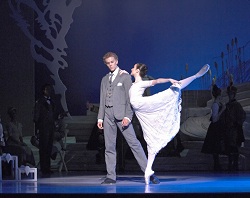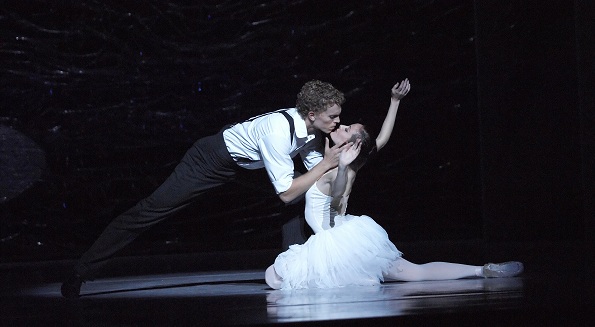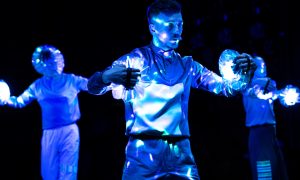By Stephanie Wolf.
David H. Koch Theater, Lincoln Center, New York City
June 2012
Innovation is continuously on the minds of choreographers and dancers. Yet, what defines innovative dance is nebulous. Is it something that has never been seen or experienced before? Or is it taking something considered highly traditional and making it relevant to modern society? On the Australian Ballet’s recent New York tour, the company addresses these questions—leaving a lasting impression on the city’s dance-enthusiasts with Graeme Murphy’s bold, original interpretation of Swan Lake.
Swan Lake is the consummate classical ballet; the most recognized production was choreographed in 1895 by Marius Petipa and has been re-staged by ballet companies all over the world. Most dancers have come to expect a particular formula for the dramatic ballet; young Prince Siegfried celebrates his 21st birthday with joyous dances in Act 1; in the “White Act”, he encounters the Swan Queen, Odette, and the star-crossed lovers dance a heart-wrenching adagio; Act III’s Black Swan Pas de Deux, danced by the evil Odile and Siegfried, is famous in its own right; and Act IV unites the lovers in either death or happiness, depending on the production.
Murphy decides to create his Swan Lake for a new century. He maintains the title of the ballet and the black-and-white aesthetics, but takes artistic liberties on every other aspect, crafting a new storyline to string together his series of intricate partnering and difficult steps.

Adam Bull & Amber Scott in The Australian Ballet's Swan Lake. Photo by Jim McFarlane
The ballet opens to a woman in a white dress; her back faces the audience and her arms cross her chest. She begins to ripple her supple arms, prompting the first few chords of the overture. The main characters: Odette (Amber Scott), Siegfried (Adam Bull), and Baroness von Rothbart (Lana Jones), are introduced through a series of vignettes. It’s clear this is a darker Swan Lake, exploring love’s ability to consume and torment the psyche. The scene transitions into the wedding festivities of Odette and Siegfried.
Amongst the abundance of ensemble dancing, a love triangle between the newlyweds and the Baroness, unfolds. Odette drives herself mad over her jealousy and suspicions of Siegfried’s betrayal—reminiscent of the mad scene from Giselle. Scott is compelling in her frenzied state.
For those accustomed to a traditional staging, the first act can be jarring. Murphy’s choreography feels hurried—though executed seamlessly by the dancers—and he borrows music traditionally reserved for the Black Swan Pas de Deux in Act III. It moves slowly and Murphy makes odd choreographic choices, creating images that are sometimes unattractive. There is no balletic rule demanding visually appealing movement, but much of the choreography feels overly complicated and cumbersome. The highlight is the Hungarian Dance to the czardas, but the rest leaves the audience feeling anxious. It’s difficult to identify if the choreography would have resonated differently in another context or if it simply didn’t work.
Act II opens in a sanatorium; Odette is committed and, after a visit from Siegfried, has tormented dreams of swans. Here, Murphy finds his niche. Kristian Fredrikson’s minimalistic sets and costumes create a stunning contemporary vision of an isolated lake, teeming with maiden swans that take their time emerging from their positions perched atop a circular platform. They move authentically, often piked forward at the hips with their ‘wings’ caressing the length of their backs. Murphy’s choreography no longer feels laborious, but has a new freedom and fluidity. He wins the somewhat hesitant audience over with this iconic act, especially in the dance of the four cygnets—in which he plays on the traditional patterns and facings of the interconnected little swans. Danced supremely by Halaina Hills, Heidi Martin, Karen Nanasca, and Brooke Lockett, the difficult choreography is inventive and works well. Scott and Bull’s Act II adagio is poetic, plucking gently at the heartstrings of the audience. As the curtain falls, there is a new energy in the auditorium.
Act III opens with a party at the Baroness’s home. Odette, recovered from her insanity, arrives at the party in a white dress and gauzy overcoat, setting her apart from the dark scenery and costuming of the act. The effect is captivating, as she seems to eminent purity and glides from one party guest to another in a series of suspended lifts; thus, re-capturing Siegfried’s heart. Scott and Bull dance another tender pas de deux, drawing gasps from onlookers; followed by an enraged solo, danced passionately by Jones.
Odette flees the party to avoid being recommitted and Siegfried follows her to the lake. Again, Murphy’s choreographic strengths are highlighted. His interpretation of the ballet’s most powerful acts and perception of how a swan might actually move is mesmerizing. Now, the swans are black and the imminent sense of tragedy and desperation exists in their every move. Despite having re-won Siegfried’s love, Odette knows she will never feel at ease; she turns to the lake to find eternal peace in its watery depths. Her descent into the shimmering black lake, as Siegfried mourns at the edge, is stunning and haunting, drawing tears from several audience members.
While it took a while to warm up to the unique interpretation on this classic ballet story, Murphy and the Australian Ballet should be commended for taking risks and committing to the production. The ballet goes against the expected and stirs up powerful emotions in its viewers. Making society think and feel differently is the mission of most artists. Murphy and the dancers succeed on both fronts.
Top photo: Adam Bull & Amber Scott in The Australian Ballet’s Swan Lake. Photography Jim McFarlane.















